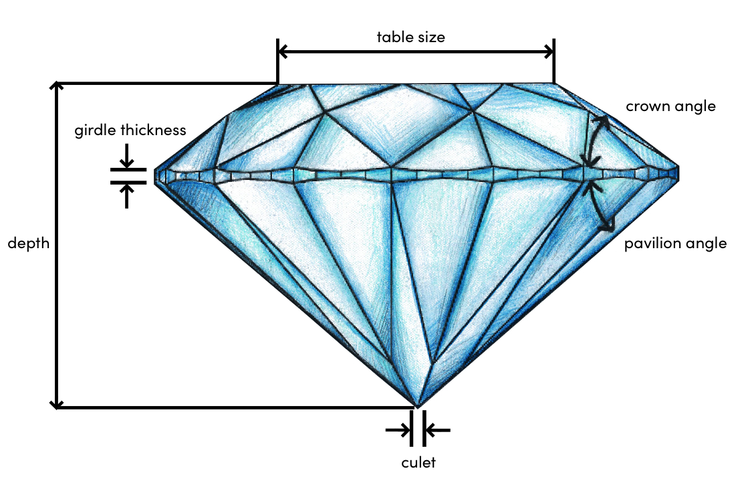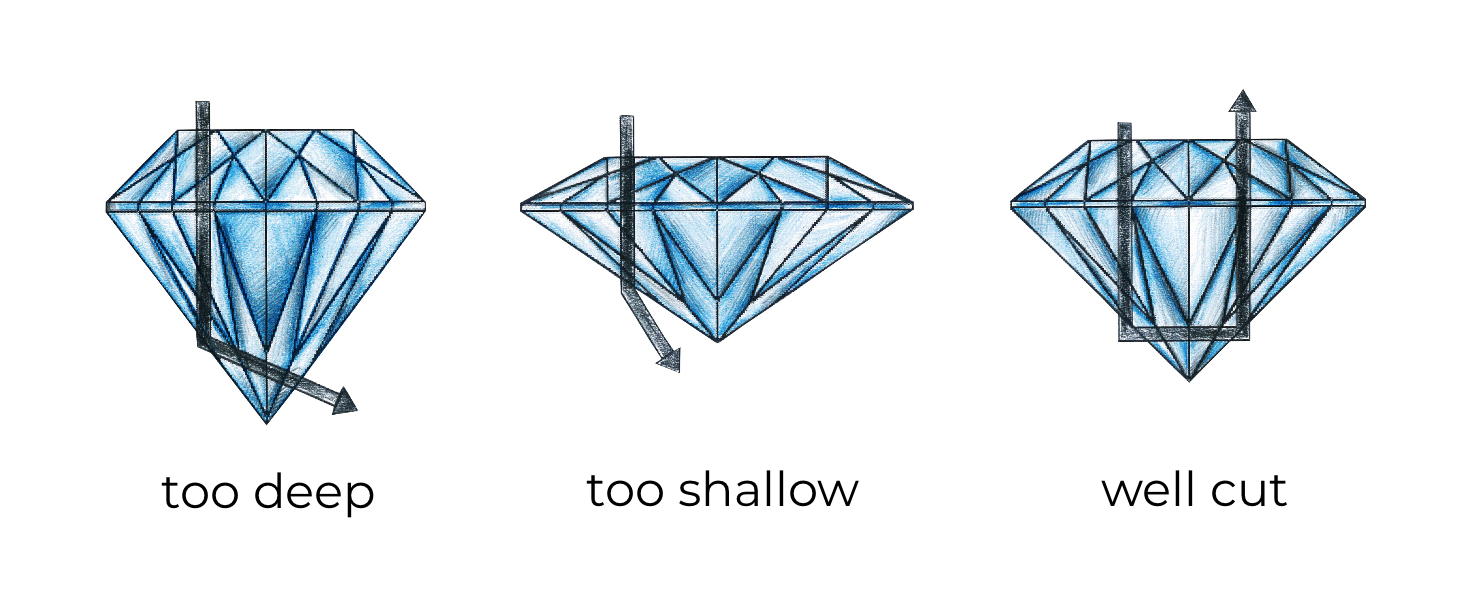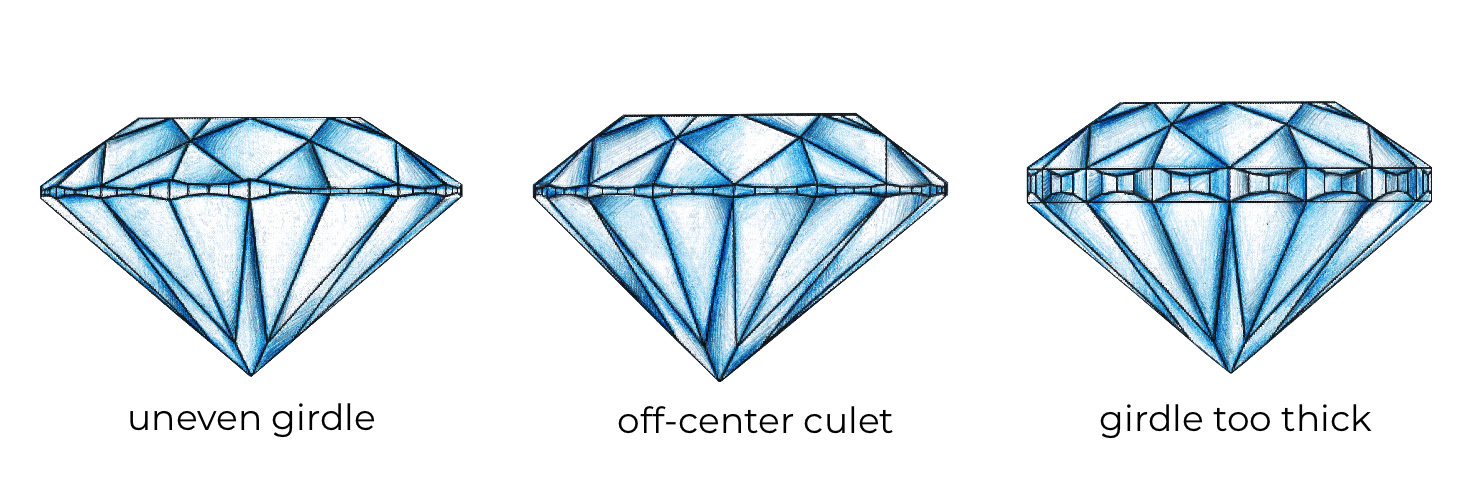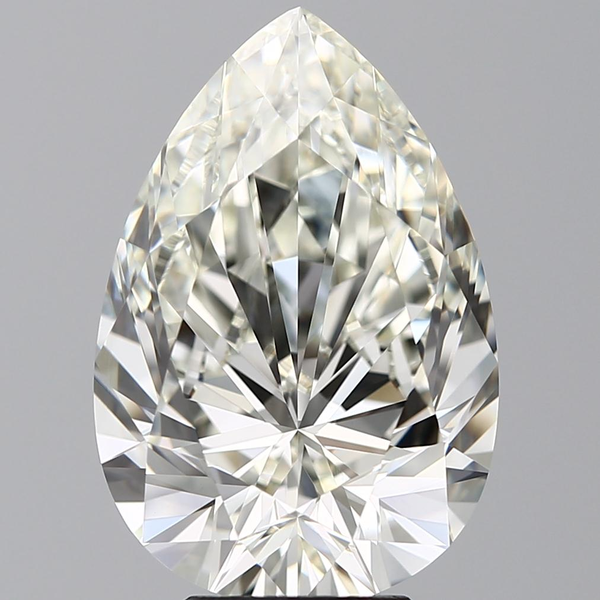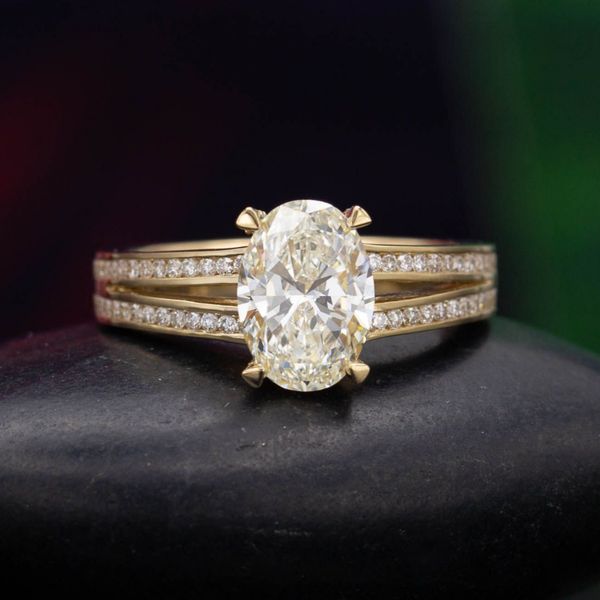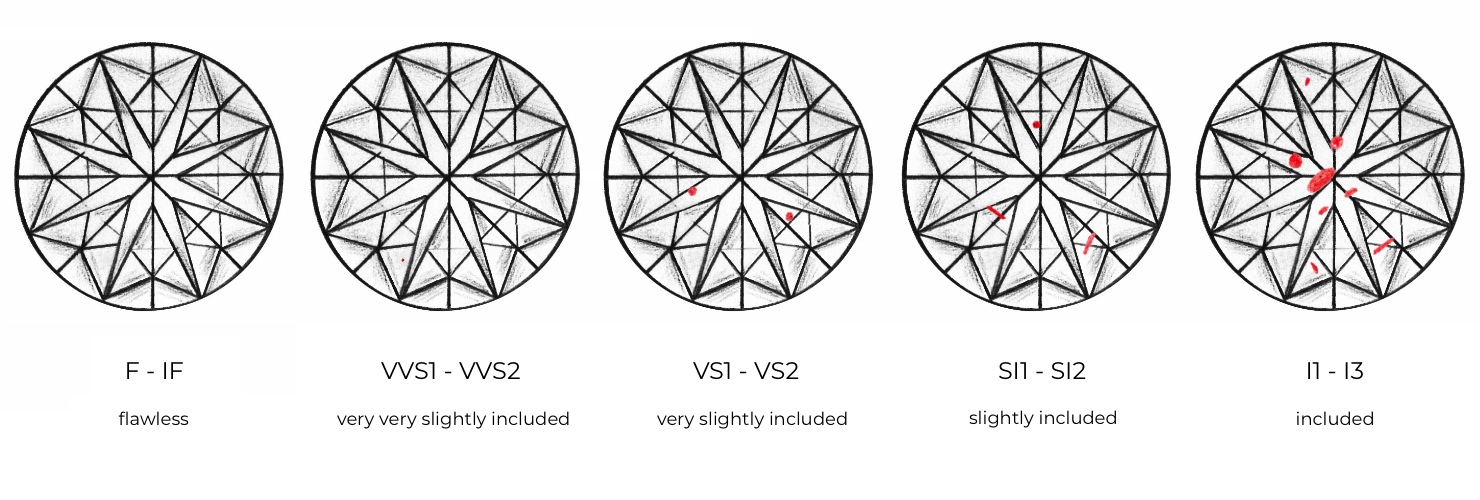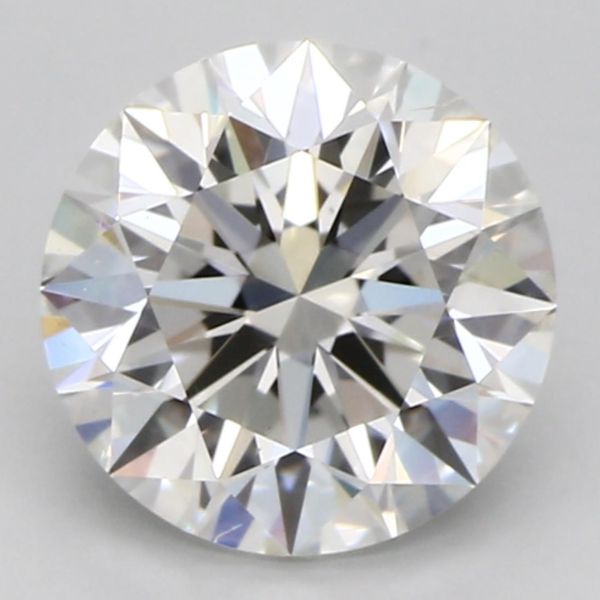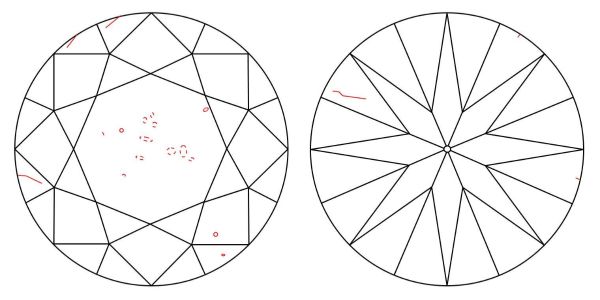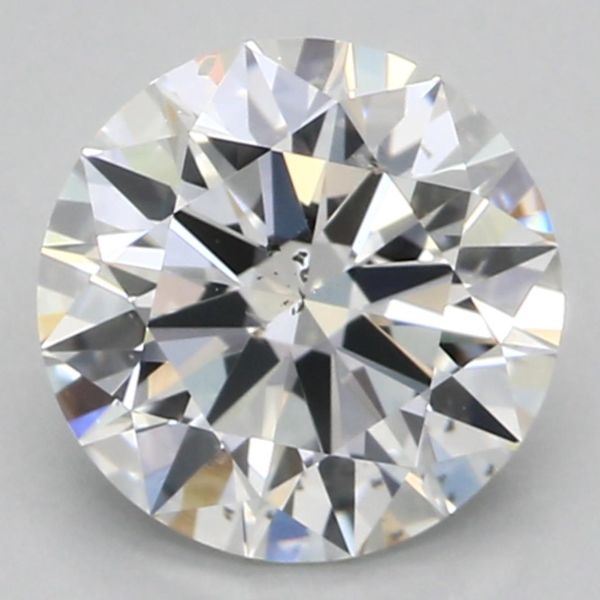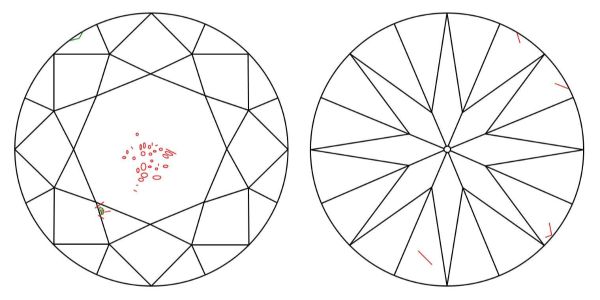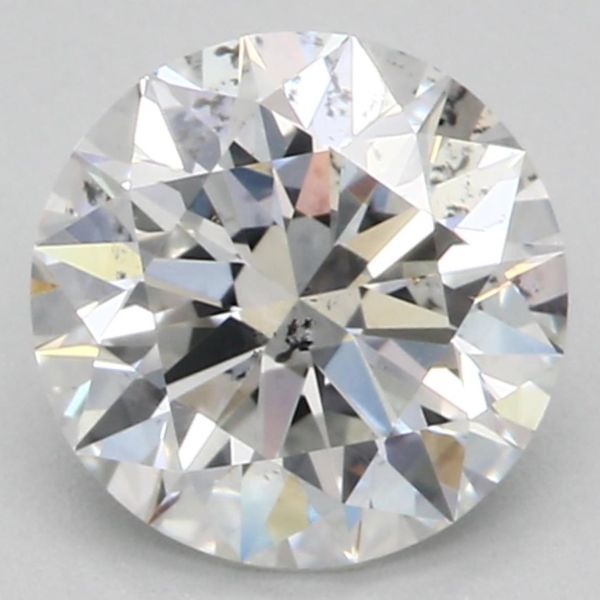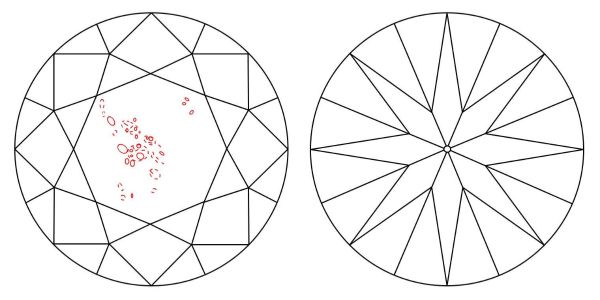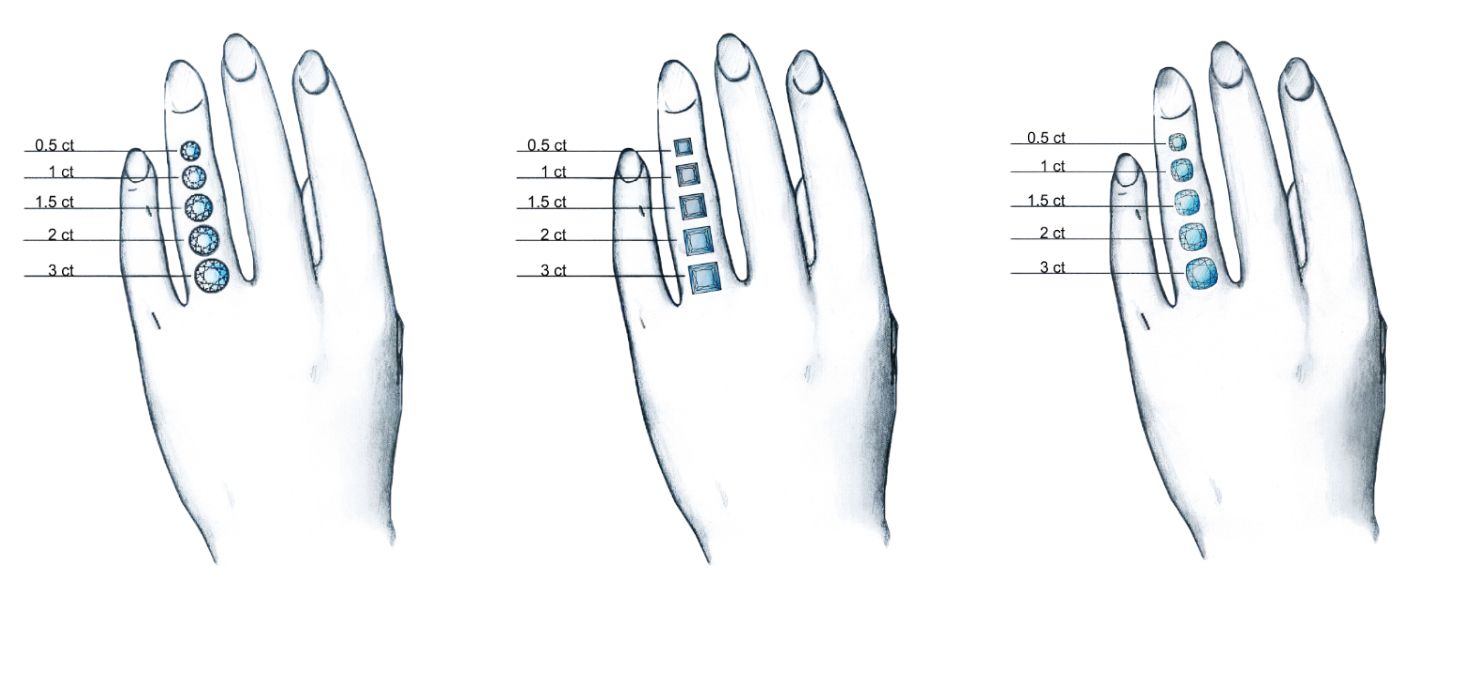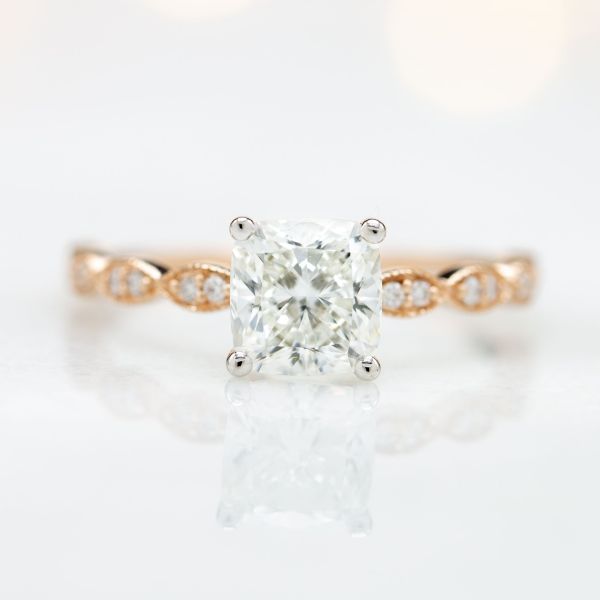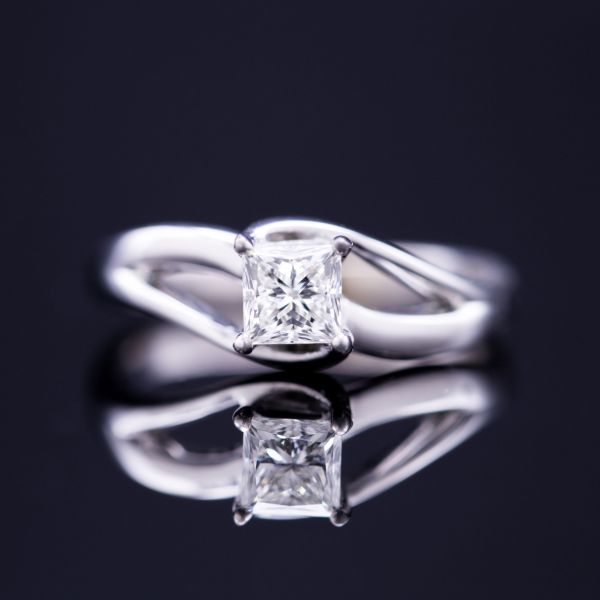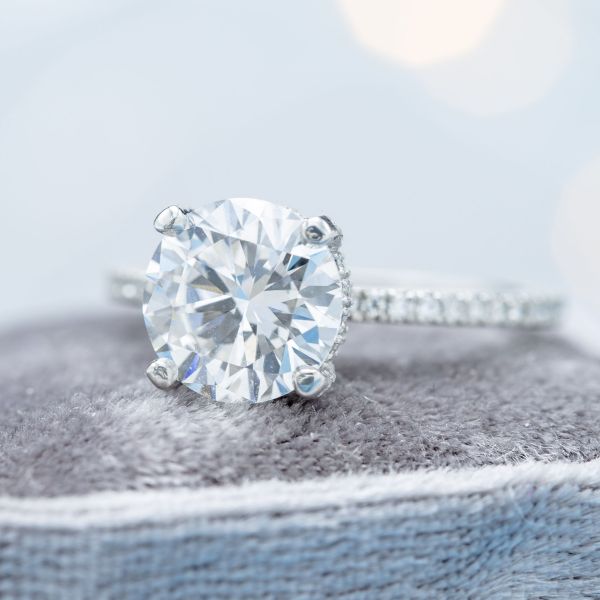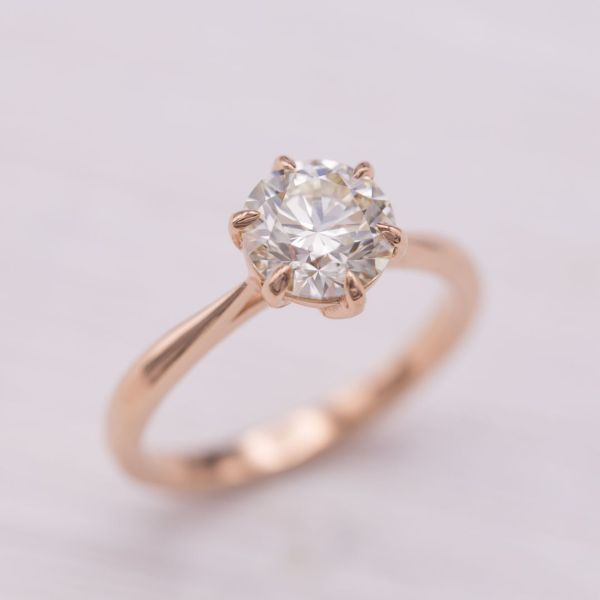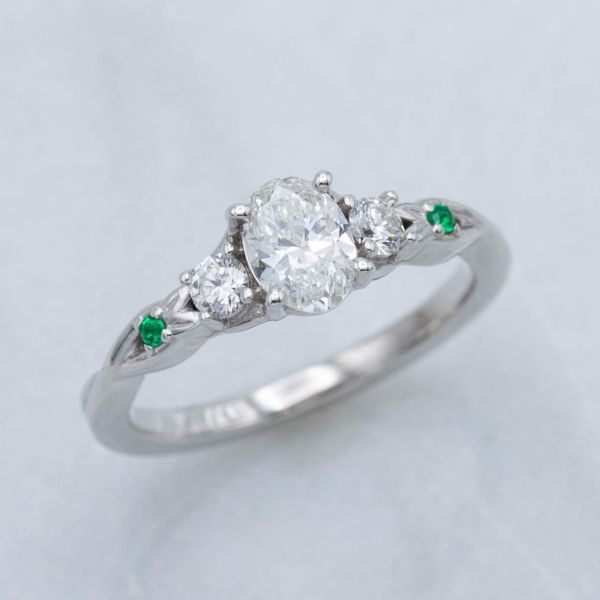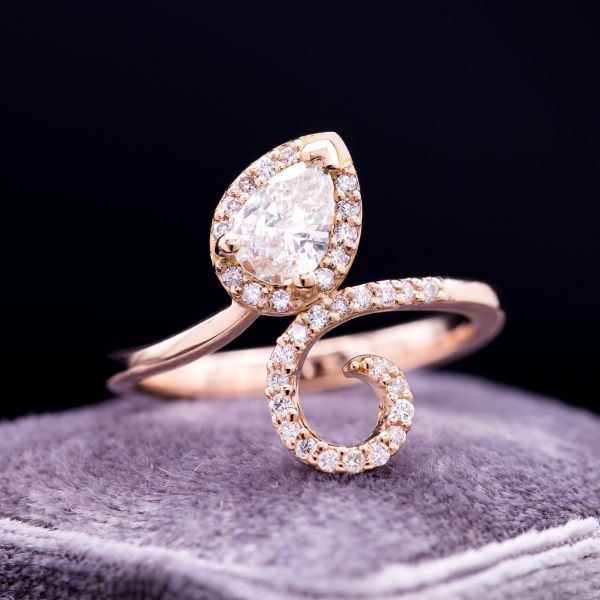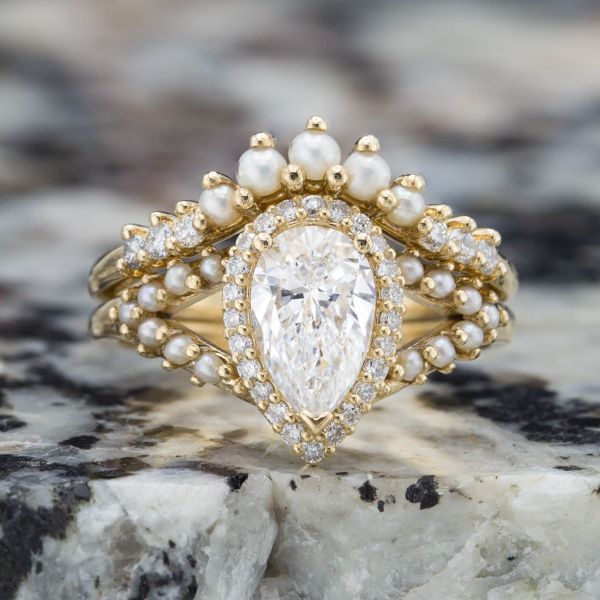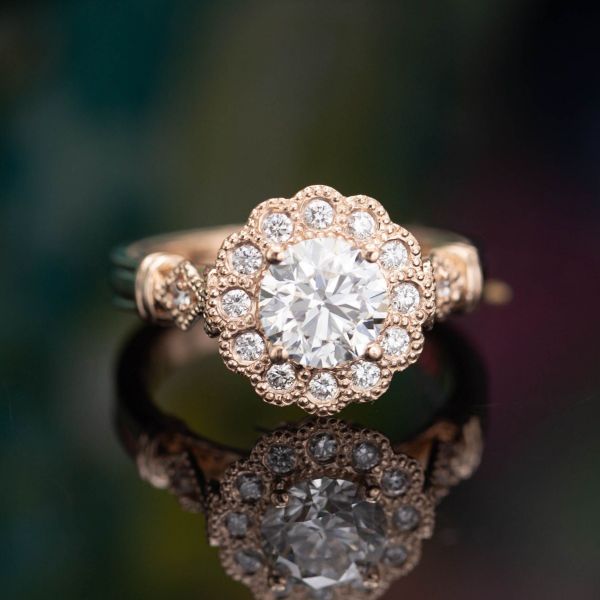Diamond Knowledge
Diamond Basics: Understanding the 4Cs
Learn how diamonds are graded on cut, color, clarity and carat weight to get a perfect center stone at a great value.
What are the 4 Cs of Diamonds?
The 4Cs refer to a global standard for the four primary characteristics of a diamond: Cut, Color, Clarity, and Carat. These characteristics interact to produce the beauty and sparkle that make diamonds so attractive.
If you're planning to buy a diamond, it's important to build a basic understanding of what these terms refer to and why the grades are important. However, if you're planning to make a purchase based on this knowledge alone, watch out. Jewelers often try to unload substandard diamonds on confident customers who have done their own research. The 4Cs are a critical starting point, but those grades alone aren't enough to make a purchase decision. Working with an expert you trust will help you get a better diamond and a better price.
Why is that? We'll explain why in our "expert's note" on each of the 4Cs.
Cut1
Cut is critical to a diamond's beauty and isn't an area to look for savings. GIA grading provides a good guide to cut for round brilliant cut diamonds, but no guidance on other shapes. For non-rounds, it's essential to work with an expert and review high-quality visuals of the diamond.
A diamond's cut grade measures how all the dimensions of the stone interact to produce a visual effect. The cut of the stone is what gives a diamond its sparkle, fire, and brilliance. A poorly cut stone will look dead - either dark or see-through like glass. Getting a well-cut diamond has a huge impact on appearance, which is why it is typically referred to as the most important of the 4Cs.
GIA has a comprehensive set of standards for analyzing round brilliant cut diamonds, which they've designed to maximize desirable visual effects, primarily:
- Brightness: Internal and external white light reflected from a diamond
- Fire: The scattering of white light into all the colors of the rainbow
- Scintillation: The amount of sparkle a diamond produces, and the pattern of light and dark areas caused by reflections within the diamond
Expert's note
If you're buying any shape other than a round brilliant, there are no universally accepted standards and GIA provides no cut grade on their report. Wait - what? That's right, GIA does not grade cut for any diamond shape other than round brilliant. Retailers that provide cut grades (e.g. very good, excellent, ideal) for fancy shapes do so based on their own discretion. These grades aren't backed by a reliable third party. Be careful when you set the cut selector in your diamond search to "ideal" for your oval diamond. "Ideal" is not a term that GIA uses and they don't issue cut grades for oval diamonds. If you want excellent light return, complimentary depth and table percentages, limited bow tie effect, and a pleasing length-to-width ratio, you'll want to work with an expert you can trust.
If you're buying a round diamond, GIA's system provides a solid foundation. You should limit your search to diamonds with GIA-graded excellent cuts. However, keep in mind that 50-60% of all diamonds that GIA grades get excellent cut ratings, so there are levels of cut quality within excellent. If you're looking to maximize your spread, have a chip-resistant girdle, or have specific symmetry features like hearts and arrows, you'll want to get help from an expert that can analyze beyond an excellent cut grade.
Color2
A diamond's color rating refers to its level of colorlessness, specifically the presence of yellow tint. Small differences in grades are subtle and can be outweighed by other factors like the shape of the diamond and the metal it's set in. If you understand these factors, you can save money without compromising on a colorless appearance.
Diamond color grading is focused on measuring the absence of color. The degree of colorlessness is ranked from D to Z, with D representing completely colorless and color increasing down to a rating of Z. These grades are very finely tuned and even trained gemologists have difficultly distinguishing between adjacent color grades, like F and G, under natural conditions. For standardization, color grading is done under controlled lighting and viewing conditions.
Expert's note
Color is reliably graded by GIA, with specific and accurate results. As a customer, it's easier to research and make an informed decision on color than on cut or clarity. The primary challenge is knowing what level of color you need to pay for to ensure your diamond looks colorless. You don't want an off-color stone, but you also don't want to pay 50% more for a color distinction you won't even be able to notice. Your color need will vary based on the shape, cut, and size of your diamond in combination with the metal type and accent stones in your mounting. Large radiant cut diamonds set in a platinum halo will show their color the most, while small round diamonds set in a yellow gold bezel will show their color the least.
- Shape: Each shape is structured differently with a different faceting pattern. The faceting pattern causes light to bounce around inside the diamond and back to your eye. Some patterns work like a prism and produce multicolored sparkle, called "fire". Round diamonds in particular are known for this. That fire will hide minor color tint in the diamond. By contrast, some faceting patterns cause a diamond's color to double back on itself, enhancing any yellow tint. You can see this happen toward the tip of the K color pear shape diamond pictured here.
- Contrast: Diamonds are always color graded in comparison to standard diamonds with known color grades. These points of reference make the diamond's color easier to place. This can work in two ways. A halo of high-quality diamonds provides a colorless contrast that can make a color tinted diamond look yellower by comparison. To avoid this issue, diamond center stones should have color grades that match or exceed the surrounding melee.
- Reflection: Similar to mirrors and shiny metal, diamonds are reflective. That means they pick up color from around them. Any mounting will provide reflection and hide the diamond's true color. That's why during grading, diamonds are viewed unmounted, on a white surface, under standard lighting. The reflection of a yellow gold or rose gold mounting will cause more color than most mild color tints, so it can serve to hide some of a diamond's natural color. When setting a diamond in a yellow or rose gold setting, we typically recommend going a bit lower on the color scale to get the best value.
- Size: Larger diamonds provide more for your eye to notice. They also provide more time for any color tint to accumulate before it returns to your eye. We recommend inching up color grades as you go up in carat weight.
One more critical note - GIA's color grade usually refers to the amount of yellow color in the diamond, but it can also refer to the presence of brown, gray, or green. We review any diamond we're considering for these alternative color tints, which aren't labeled on GIA reports for stones graded J color or higher. Green tinge in particular is important as it's characteristic of diamonds from the Marange mines in Zimbabwe, which historically have been associated with human rights abuses. We never sell Marange diamonds, but other dealers might, since they aren't technically considered conflict diamonds.
Clarity3
Clarity grades tell you about a diamond's imperfections. GIA's grading system is based on what is visible under magnification, which is a mediocre guide to what impacts the diamond's visual appeal to the naked eye. A diamond expert can help you take advantage of this system to find a great deal by identifying an eye clean diamond with a low GIA grade.
Diamonds are formed under intense heat and pressure in a process that takes over a billion years in nature. Over the course of formation, any number of imperfections can be introduced. For gem quality diamonds these are referred to as inclusions if they are internal and blemishes if they are external.
GIA's diamond clarity scale has 11 grades ranging from Flawless (FL) to Included (I). The classification system focuses on how difficult it is for a skilled grader to see inclusions and blemishes under 10x magnification. Here are GIA's definitions:
- Flawless (FL): No inclusions or blemishes are visible to a skilled grader using 10× magnification
- Internally Flawless (IF): No inclusions and only blemishes are visible to a skilled grader using 10× magnification
- Very, Very Slightly Included (VVS1 and VVS2): Inclusions are difficult for a skilled grader to see under 10× magnification
- Very Slightly Included (VS1 and VS2): Inclusions are minor and range from difficult to somewhat easy for a skilled grader to see under 10x magnification
- Slightly Included (SI1 and SI2): Inclusions are noticeable to a skilled grader under 10x magnification
- Included (I1, I2, and I3): Inclusions are obvious under 10× magnification and may affect transparency and brilliance
Expert's note
In our view, the focus on how a diamond looks under 10x magnification is a key shortcoming of the grading system. Most people care about how a diamond looks to the naked eye, not how it looks under a microscope. Most gem-quality diamonds sold are classified as Very Slightly Included (VS) or Slightly Included (SI). It's specifically at these ratings where the system provides the least guidance. Some inclusions that are easy to see under 10x magnification have no impact on the visual appeal of the diamond to the naked eye. Others are harder to see under 10x magnification, but hurt the visual appeal of the diamond as a whole.
Take a look at these three diamonds, each of which has been graded by GIA at the same color, clarity and cut grade: G, SI1, Excellent. You'll see that the three stones look substantially different. One of the stones has a brownish tinge, which is not reflected in the color or clarity grades. Two of them have very dark inclusions positioned near the center of the table and reflected back at the eye to make them look far less appealing. A perfect and surprisingly common example of how the overall clarity grade can fall short in telling the story of how the diamond will look.
For more on this conundrum, see our analysis of diamonds with the same clarity grades.
This shortcoming isn't all bad. If you understand the system, you can find great deals by finding an eye clean diamond with a low clarity grade. We know this can be hard for a non-expert, which is why we review and hand-select diamonds personally - offering you exceptionally clean VS, SI, and (in unique cases) I options to choose from.
- Smart buys have inclusions that are small, light in color, and tucked near facets and the sides of the diamond
- Poor buys have inclusions that are larger, dark in color, or numerous, located in the table or the pavilion, where they can be reflected all around the stone. They might also display milkiness from tiny clouds all through the stone or inclusions that put the diamond at risk of chipping with wear.
Carat4
Diamond size is typically expressed in carat weight, which is a good, but imperfect measure of how big the diamond will look. If you're considering multiple shapes or multiple gem types, you should be particularly careful to review your diamond's mm dimensions.
Carat weight is the standard unit of measure for diamonds. It originally derives from an ancient unit of measure called the carob seed. These seeds were roughly uniform in size and weight so they were used as early units of measure. The modern carat is equivalent to 200mg.
Carat weight is closely correlated to (but not identical to) a diamond's dimensions. The face up dimensions of a diamond are often referred to as the spread. A 1.0ct round brilliant cut diamond with an excellent cut will have a spread of roughly 6.4-6.5mm.
Some diamond shapes look bigger than others at a given carat weight. For example, a 1ct cushion cut diamond will generally look smaller than a 1ct round, while a 1ct emerald will look larger. This is because different shapes store their weight differently, some spreading wide, like trillions, others stretching deep for brilliant light return, like rounds.
Be extra careful when comparing the size of a diamond to the size of other gems. Different gems have different densities and thus different carat weights, even at the exact same dimensions. For example, a 6.5mm round diamond may weigh 1ct, while a 6.5mm round alexandrite may weigh closer to 2ct! That's why we always recommend using mm size in addition to carat weight when referring to non-diamond gems.
Expert's note
Carat weight is relatively straightforward if you also make sure to keep in mind mm dimensions. That said, there are a couple other tricks to keep in mind that can help you make a smart choice:
- Pay attention to "magic numbers": 0.5ct, 1.0ct, 1.5ct, and 2.0ct are what diamond cutters like to call magic numbers, since many customers come in looking for diamonds at these sizes. As you can probably guess, there's a lot more demand for 1.0ct diamonds than 0.9ct diamonds because lots of customers come in looking for a 1ct stone. More demand means higher prices and sure enough, prices jump up at each magic number. Going just under magic numbers can be a good way to save a lot of money for a small change in visual appeal.
- Be careful with .00 sizes: Diamond cutters know all about magic numbers, which means they do whatever they can to stay above them when cutting. Sometimes this means making suboptimal cuts that hurt a stone's visual appeal, but help to save carat weight. Diamonds with weights like 1.00ct and 2.00ct mean the cutter went right up to the line and might have cut a few corners to stay above weight. We take an extra careful look at diamonds with these weights or avoid them altogether.
Oh, and one final thought. There's no wrong size! We've made exceptional rings with diamonds in all shapes and sizes. Whether you're constrained by budget or worried about a setting a big diamond in a way that's not overly bulky, we can design style and setting choices that suit just about any carat weight. Have a look at this handful of rings, with diamonds in all shapes and sizes. We think you'll agree that they all look beautiful!
About CustomMade
CustomMade designs and creates one-of-a-kind, custom engagement rings and fine jewelry. Each piece we create is inspired by you, designed for you, and made just for you.
